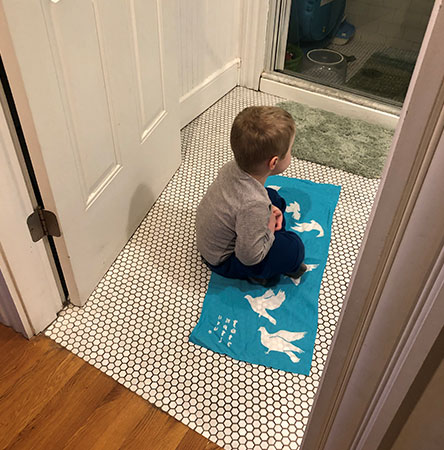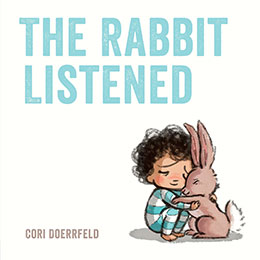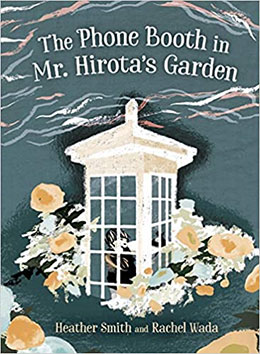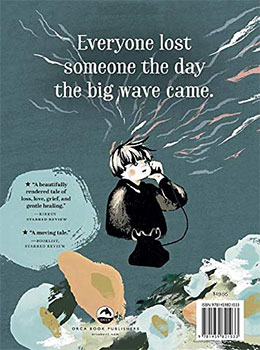Caren: Some days are tough. During this COVID-19 pandemic, our children face plenty of challenges. Loss of playground time. Loss of playdates. Changes in school routines. Changes in home routines. These days, children may need more time alone on a “peace blanket” to grieve their former lives. The rest of us may need the same.

There are many ways to soothe when coping with loss and grief. Stories can help too. One of the most profound picture books about grief I’ve come across is The Phone Booth in Mr. Hirota’s Garden by Heather Smith, illustrated by Rachel Wada.
One NPR This American Life podcast inspired Heather Smith to share Mr. Sasaki’s story. Mr. Sasaki was heartbroken when his cousin died. As a way to heal, he bought an old-fashioned telephone booth and placed it on a hill near his Japanese home overlooking the Pacific Ocean. In it, he added an old rotary telephone connected to nowhere. He called it his “wind telephone.” Whenever he needed to “talk” with his dead cousin, he would go to the booth, pick up the phone, and let his words of love be carried by the wind.
On March 13, 2011, the largest earthquake recorded in Japan struck, triggering a massive tsunami and causing a frightening nuclear plant accident. Over 19,000 people lost their lives, 2,500 are still missing. Mr. Sasaki’s phone booth survived and soon became a landmark for others grieving for their loved ones. After talking on the “wind telephone,” one woman said, “We were so broken. Talking on the phone today changed something.” That something is the beginning of healing and a search for personal peace.
The Phone Booth in Mr. Hirota’s Garden fictionalizes this story for a young audience. Young Makio loses his father in the great tsunami. Mr. Hiorta loses his daughter. One day, Makio hears Mr. Hirota hammering away, building, of all things, a phone booth. Hearing Mr. Hirota speak to his lost daughter, Makio finally finds his way to the phone booth. He picks up the phone to nowhere and pours out his heart.
The Phone Booth in Mr. Hirota’s Garden takes place after the tsunami no one could control. Our children face a viral tsunami. What can we do to comfort our children as we grieve ourselves?
Caren and Ellie: Going Deeper — Supporting a Grieving Child
 The National Alliance for Grieving Children is a helpful resource. Among the many suggestions, experts remind— us of ten ways to help children through the grief process: • Take care of yourself • Be honest • Listen • Acknowledge your child’s grief • Share • Be creative • Maintain clear expectations • Reassure your child • Create new rituals and traditions • Be patient.
The National Alliance for Grieving Children is a helpful resource. Among the many suggestions, experts remind— us of ten ways to help children through the grief process: • Take care of yourself • Be honest • Listen • Acknowledge your child’s grief • Share • Be creative • Maintain clear expectations • Reassure your child • Create new rituals and traditions • Be patient.
The picture book, The Rabbit Listened by Cori Doerrfeld, tenderly illustrates these ten steps to remind adults of the importance of patience and listening while reassuring children that it’s possible to overcome dark moments
Caren and Ellie: More Pathways to Peace While Grieving
 Peace as a slinky: Think of grief, not as a linear series of stages, but as a spiraling journey.
Peace as a slinky: Think of grief, not as a linear series of stages, but as a spiraling journey.
Some days are difficult. Some days are brighter. We will always miss our loved ones, or forever harbor shadows of traumatic events, but in time and healing, grief can find its place along the continuüm of the spiraling life of our future selves.
 Peace in a rocking chair: In My Grandmother’s Hands: Racialized Trauma and the Pathway to Mending Our Hearts and Bodies, author Resmaa Menakem speaks to the physiology of trauma and the vagus nerve, Menakem calls the “soul nerve.” The vagus nerve is “where you experience a felt sense of love, compassion, fear, grief, dread, sadness, loneliness … (148) Rocking is one of the most instinctively human ways to sooth our bodies. Rocking with a child on our lap is one of the most natural and healing ways to cope with our difficult times.
Peace in a rocking chair: In My Grandmother’s Hands: Racialized Trauma and the Pathway to Mending Our Hearts and Bodies, author Resmaa Menakem speaks to the physiology of trauma and the vagus nerve, Menakem calls the “soul nerve.” The vagus nerve is “where you experience a felt sense of love, compassion, fear, grief, dread, sadness, loneliness … (148) Rocking is one of the most instinctively human ways to sooth our bodies. Rocking with a child on our lap is one of the most natural and healing ways to cope with our difficult times.
 Peace on the page: Julia Cho’s December 30, 2020 New York Times article, “A 12-Year-Old’s Letter to her Post-Pandemic Self” asks: How will you retain gratitude for the return to normal life? Cho’s daughter’s response is a letter to herself: “I’ve come from 2020 to remind you not to forget.”
Peace on the page: Julia Cho’s December 30, 2020 New York Times article, “A 12-Year-Old’s Letter to her Post-Pandemic Self” asks: How will you retain gratitude for the return to normal life? Cho’s daughter’s response is a letter to herself: “I’ve come from 2020 to remind you not to forget.”
Time may not heal all wounds, but time, love, listening, understanding — and stories — can help children, and the rest of us, find healing pathways to peace as we grieve.
_________________________
For each Peace-ology post, Caren and Ellie partner to learn and explore the meaning of peace by talking and listening with each other. If you’d like to share your ideas about peace, books, and children, please share your comments here, or visit our websites.



What a helpful post. I’m sending this to a dear friend who is walking her children (and herself) through grief upon the impending death of her husband/their father.
April, thank you for your response to our blog about grieving. I’m so glad you found it helpful and I sure hope your friend does too. Ellie and my hearts are with you and your friend as she walks such a difficult path. Again, thanks for reaching out to us. Best, Caren